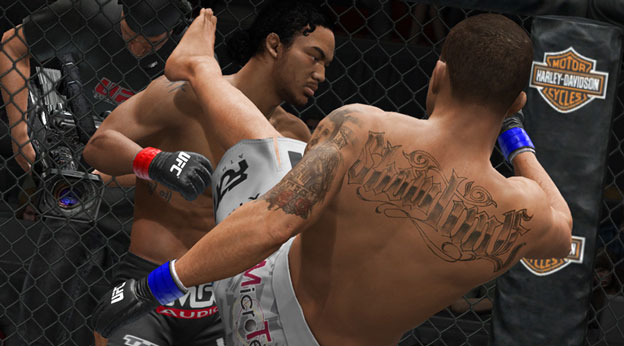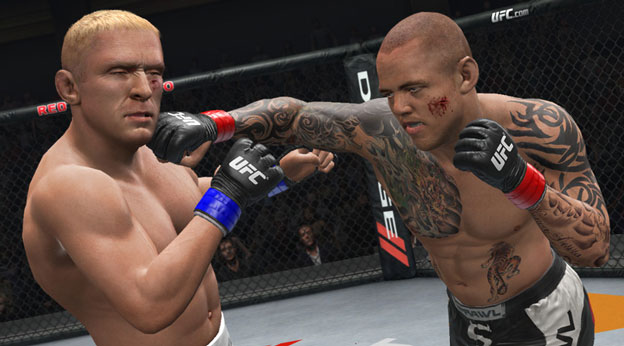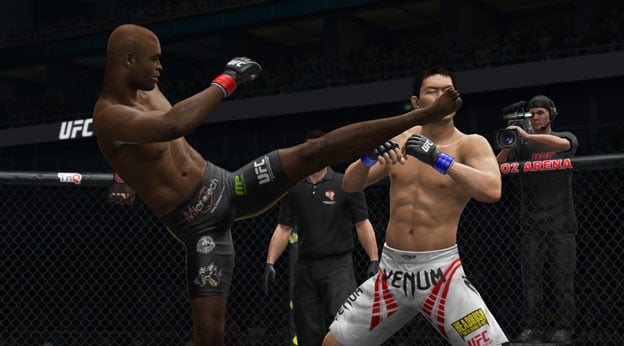You’re The Best Around
Maybe it puts me in the minority, but I didn’t like UFC Undisputed 2010. It was certainly a serviceable MMA game, but the systems at work behind the scenes were obtuse and unclear. Improvement was a frustrating exercise in trial and error, and rapidly mashing ambiguous inputs were met with uncertain, if any, effect. To be fair, that’s how most sports games feel for me: exercises in abstract control. It spoke to me, however, that THQ gave its potentially annual series the year off in 2011, forgoing a yearly entry for a two-year development cycle. Perhaps I wasn’t the only one less-than-enthused by the Undisputed series’ second outing.
That second year shows. UFC Undisputed 3 throws in a wealth of new features and overhauls the basic gameplay in ways that don’t entirely undermine what was there before, instead refining and refocusing it. I was only with the game for a few hours, so it’s impossible to say if this polish carries through the entire experience, but what I saw almost immediately struck a positive chord with me.

The animations were the first thing that struck me: faster, sharper, but somehow more natural than before. Previous Undisputed titles were plodding affairs, with strikes that often lacked impact due to the leisurely pace with which they flew forth. In Undisputed 3, matches feel more action-packed and hits are more visceral—especially in the new Pride mode. Even sways feel more “on point” as one snaps back just out of reach of the opponent’s arm.
Sways aren’t one’s only means of defense against powerful head blows anymore, though. Players can now catch incoming attacks, transitioning into either a clinch, a takedown, or a strike, depending on what blow is countered, and low kicks can be “checked” using the same mechanic. Heavier blows can also be interrupted by basic jabs, quick strikes landing first, and throwing off a cross’ or hook’s trajectory. All of this comes together to take the striking emphasis off of powerful haymakers and transfer it to jabs and combinations. The new feinting mechanic piles on another layer of strategy (and players can feint more than just strikes), but it feels a bit awkward to activate, requiring both right shoulder buttons to be held down while performing the desired feint.
For grappling, there’s now an “amateur” control option for transitions, allowing players to attempt a minor or major transition with a mere flick of the right stick instead of having to swing it in an arc. With the traditional control scheme, though, transitions can now be feinted by simply not completing them, opening up another element of strategy to players willing to stick it out with the somewhat ambiguous, original controls. Further, ground swaying allows one to avoid match-ending blows an opponent can throw from the top, and those on the bottom can catch a punch from a posturing opponent to either pull them in or perform a submission.
Submissions have changed significantly, no longer relying on stick wiggling. Instead, the only required HUD element of the game shows up—an octagon on which the two players control a pair of colored bars. The attacker wants these bars to overlap until his opponent is submitted, while the defender attempts to escape. It’s a little cheesy looking, but a much fairer system than the stick wiggling of 2010 or the broken button mashing of 2009.
Dozens of smaller changes pepper the fighting as well, from cage-based transitions to back-transitions and both body and leg knockouts (players can turn on a full HUD that shows fighter stamina and “paper dolls” that indicate damage to fighters’ body parts), and leg check TKOs are a possibility.

Match options have expanded as well. In addition to weight classes and number of rounds, players can now choose to play under rulesets that equalize fighters’ stats, making matches purely technique based, and turn off semi-random events like doctor stoppages and flash knockouts. A “simulation” mode is available that increases the damage fighters take as well as the stamina they expend while fighting. This is all, of course, in addition to the new Pride mode, which not only brings a selection of fighters from the Pride tournament into the mix (as well as some older versions of UFC favorites who got their start in the Japanese production), but changes the ruleset to disable elbows while allowing knees, kicks, and stomps to the head of a downed opponent. These look as brutal as you would expect. The mode also has a ten-minute first round (followed by two more five-minute ones) and takes place in a square, roped ring instead of the UFC’s caged-in octagon.
Career mode has seen some streamlining this time out, with stat decay excised and a greater focus on simply getting players’ created fighters into their matches. Instead of uncertain sparring, created fighters can be taken through training games, which have a very clear focus and goal (for the most part). Even sparring-based training is directed, with a bar that rewards players who are actively demonstrating the required skills or, in the case of camp training, the move they wish to learn.

Camp training, too, has changed. It’s more focused, with six camps to learn from (and eventually join) and clear rewards for participation. These are real world gyms, including the hallowed halls of legendary trainer Greg Jackson. The entire career experience is also heavily tutorialized, leading you through your first few fights on your way to the UFC and introducing you to the various aspects of training. This tutorial system extends to the fighting itself, where hints will pop up, interrupting the action, to introduce new concepts or reacquaint the player with forgotten ones. These, blessedly, can be turned off—a particularly important option for player matches.
With regard to flavor, the game looks like the UFC (or Pride, if you’re playing that mode), and feels a lot more like it than either of the previous Undisputed titles managed. Gone from career mode are the CG cutscenes, replaced with live-action footage edited together by the UFC itself. These often focus on well-known fighters talking about events relevant to your career, such as your first victory or first defeat. There’s also a roster career mode, in which players can take an actual UFC fighter through his career, altering it as one goes along (even changing that fighter’s weight class).
There are a lot of quality of life changes as well, such as the highlight reel feature (which automatically saves your last 50 rounds to the hard drive and allows them to be edited into clip shows for upload) and mirror matches, further balancing online mode.
Is UFC Undisputed 3 a must-buy game? It’s too early to say, and more time must be spent with it before a verdict can be reached. However, my initial time with it made me anxious to put more hours into every aspect of the game, and actually has me excited about ground combat in a fighting game.
Game Features:
